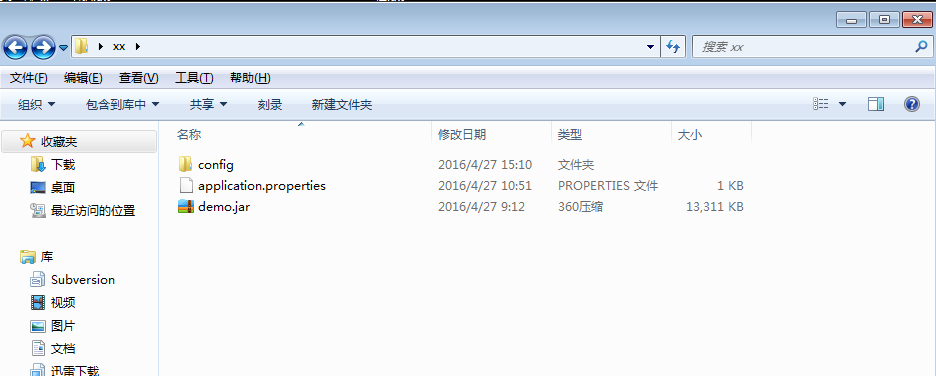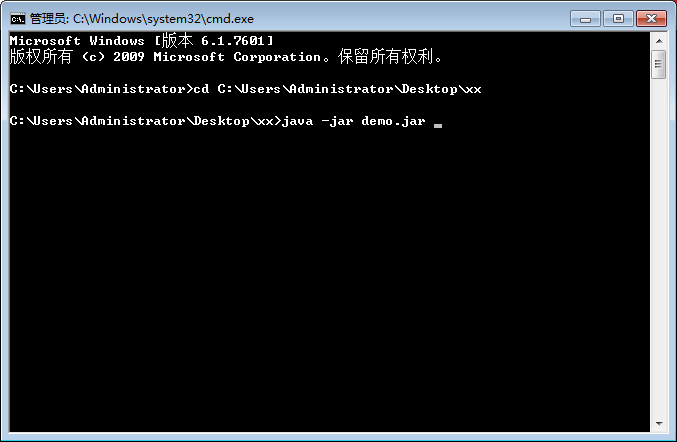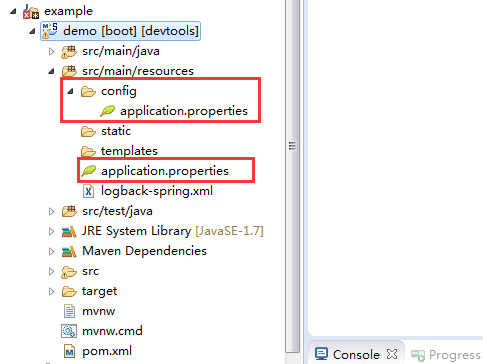springboot 配置文件 .properties和.yml的写法区别
例如 : redis配置的properties或yml文件,如下:
- spring.redis.cluster.nodes[0]=192.168.0.1:6379
- spring.redis.cluster.nodes[1]=192.168.0.2:6379
- 或
- spring:
- redis:
- cluster:
- nodes:
- - 192.168.0.1:6379
- - 192.168.0.2:6379
spring boot允许你自定义一个application.properties文件,然后放在以下的地方,来重写spring boot的环境变量或者定义你自己环境变量
- 当前目录的 “/config”的子目录下
- 当前目录下
- classpath根目录的“/config”包下
- classpath的根目录下
1点和2点适合在生产环境下,例如,打包成可执行的jar包
这里要注意,“当前目录”是指demo.jar包的目录下,要使配置文件生效,在使用Java -jar demo.jar的命令时,必须先路由到demo.jar包的路径下,再使用其命名,
3点和4点适合在开发环境下
如果同时在四个地方都有配置文件,配置文件的优先级是从1到4。
使用配置文件之后,spring boo启动时,会自动把配置信息读取到spring容器中,并覆盖spring boot的默认配置,那么,我们怎么来读取和设置这些配置信息呢
1.通过命令行来重写和配置环境变量,优先级最高,例如可以通过下面的命令来重写spring boot 内嵌tomcat的服务端口,注意“=”俩边不要有空格
java -jar demo.jar --server.port=9000- 1
- 1
如果想要设置多个变量怎么办,可以已json的格式字符串来设置
java -jar demo.jar --spring.application.json='{"foo":"bar"}'- 1
- 1
2.通过@value注解来读取
@RestController
@RequestMapping("/task")
public class TaskController { @Value("${connection.remoteAddress}") private String address; @RequestMapping(value = {"/",""}) public String hellTask(@Value("${connection.username}")String name){ return "hello task !!"; } }- 1
- 2
- 3
- 4
- 5
- 6
- 7
- 8
- 9
- 10
- 11
- 12
- 13
- 1
- 2
- 3
- 4
- 5
- 6
- 7
- 8
- 9
- 10
- 11
- 12
- 13
3.通过Environment接口来获取,只需要把接口注进去即可
@RestController
@RequestMapping("/task")
public class TaskController { @Autowired Environment ev ; @Value("${connection.remoteAddress}") private String address; @RequestMapping(value = {"/",""}) public String hellTask(@Value("${connection.username}")String name){ String password = ev.getProperty("connection.password"); return "hello task !!"; } }- 1
- 2
- 3
- 4
- 5
- 6
- 7
- 8
- 9
- 10
- 11
- 12
- 13
- 14
- 15
- 16
- 1
- 2
- 3
- 4
- 5
- 6
- 7
- 8
- 9
- 10
- 11
- 12
- 13
- 14
- 15
- 16
4.可以自定义一个工具类,来获取,这种方式关键在于读取配置文件信息,适合自定义的配置信息,spring 容器默认的配置信息会读不到
@Component
public class SystemConfig { private static Properties props ; public SystemConfig(){ try { Resource resource = new ClassPathResource("/application.properties");// props = PropertiesLoaderUtils.loadProperties(resource); } catch (IOException e) { e.printStackTrace(); } } /** * 获取属性 * @param key * @return */ public static String getProperty(String key){ return props == null ? null : props.getProperty(key); } /** * 获取属性 * @param key 属性key * @param defaultValue 属性value * @return */ public static String getProperty(String key,String defaultValue){ return props == null ? null : props.getProperty(key, defaultValue); } /** * 获取properyies属性 * @return */ public static Properties getProperties(){ return props; } } //用的话,就直接这样子 String value = SystemConfig.getProperty("key");- 1
- 2
- 3
- 4
- 5
- 6
- 7
- 8
- 9
- 10
- 11
- 12
- 13
- 14
- 15
- 16
- 17
- 18
- 19
- 20
- 21
- 22
- 23
- 24
- 25
- 26
- 27
- 28
- 29
- 30
- 31
- 32
- 33
- 34
- 35
- 36
- 37
- 38
- 39
- 40
- 41
- 42
- 43
- 44
- 45
- 46
- 47
- 48
- 49
- 50
- 51
- 1
- 2
- 3
- 4
- 5
- 6
- 7
- 8
- 9
- 10
- 11
- 12
- 13
- 14
- 15
- 16
- 17
- 18
- 19
- 20
- 21
- 22
- 23
- 24
- 25
- 26
- 27
- 28
- 29
- 30
- 31
- 32
- 33
- 34
- 35
- 36
- 37
- 38
- 39
- 40
- 41
- 42
- 43
- 44
- 45
- 46
- 47
- 48
- 49
- 50
- 51
5.可以利用${…}在application.properties引用变量
myapp.name=spring
myapp.desc=${myapp.name} nice- 1
- 2
- 1
- 2
6.可以在application.properties配置随机变量,利用的是RandomValuePropertySource类
my.secret=${random.value}
my.number=${random.int}
my.bignumber=${random.long} my.number.less.than.ten=${random.int(10)} my.number.in.range=${random.int[1024,65536]}- 1
- 2
- 3
- 4
- 5
- 1
- 2
- 3
- 4
- 5
简单的配置文件的使用就先写到这里,再看看其他高级用法,如Profiles还有@ConfigurationProperties
=================================
SpringBoot读取application.properties文件,通常有3种方式
1. @Value 例如:
@Value("${spring.profiles.active}")
private String profileActive;------相当于把properties文件中的spring.profiles.active注入到变量profileActive中
2. @ConfigurationProperties 例如:
@Component
@ConfigurationProperties(locations = "classpath:application.properties",prefix="test")
public class TestProperties {
String url;
String key;
}
其他类中使用时,就可以直接注入该TestProperties 进行访问相关的值
3. 使用Enviroment 例如:
private Enviroment env;
env.getProperty("test.url");
而env方式效率较低
注:@ConfigurationProperties也可用于其他.properties文件,只要locations指定即可

























 1686
1686

 被折叠的 条评论
为什么被折叠?
被折叠的 条评论
为什么被折叠?








